|
Title: Dissorophid diversity at the early Permian cave system near Richards Spur, Oklahoma.
Authors: B.M. Gee, J.J. Bevitt, R.R. Reisz Journal: Palaeontologia Electronica, article 22.2.46 Link to paper - this is an open access paper than anyone can read! We're really in the dog days of summer up here in Toronto (remind me not to move somewhere with humid summers for my next job), so I'm putting a spin on this for the next couple weeks with a series I'm calling "The Dog Days of Dissorophids," where I talk about my actual dissertation study system for once instead of waxing poetic about metoposaurids. This may or may not be foreshadowing an in press publication as well...
In honour of Canada Day, this week's blog post (delayed post since I'm in the field right now) covers the few (but notable) Canadian temnospondyls. Note that this is a brief, not a comprehensive history, considering there's quite a lot of articles spanning over 150 years and also that I wrote this in between a conference and packing for fieldwork (P.S. I'm in the field now, sorry about any errors or typos!).
|
About the blogA blog on all things temnospondyl written by someone who spends too much time thinking about them. Covers all aspects of temnospondyl paleobiology and ongoing research (not just mine). Categories
All
Archives
January 2024
|


 RSS Feed
RSS Feed
